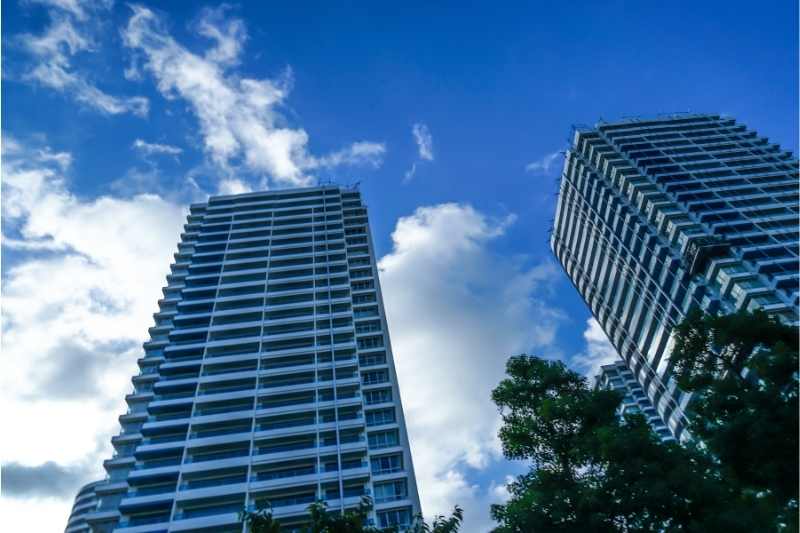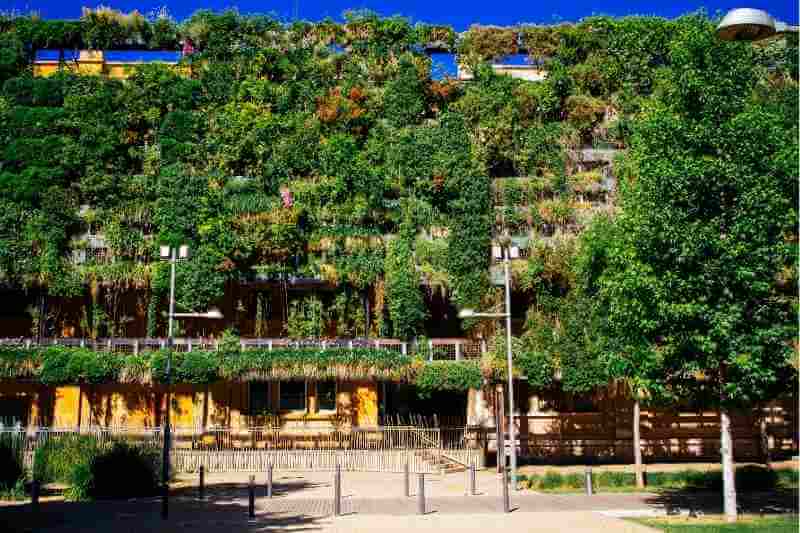Key takeaways
- High density housing is defined as real estate developments that have a higher population than average.
- Typically, urban areas have high density buildings, while suburban and rural areas have low density housing.
- Advantages of high density buildings include less traffic, increased property value, and attracting businesses and employers.
- High density real estate increases sustainability by building up, rather than demolishing buildings, reducing overall energy consumption, and encouraging less reliance on cars.

What sets cities like Los Angeles, Chicago, and New York City apart from other metroplexes across the country? Unlike most urban areas, these cities are ripe with high density housing developments!
Many growing cities currently rely on mid and low density housing. With their current infrastructure, these cities will have to add millions of single-family homes and gated communities in order to rival major urban centers. Instead, real estate developers can focus on filling urban centers with high density buildings.
In this blog post, we define high density housing and its advantages. Then, we highlight the differences between high and low density housing and explain the environmental benefits of high density apartments.
This post covers:
- What is high density housing?
- What are the advantages of high density buildings?
- Differences between low density and high density housing
- The environmental benefits of high density housing

What is high density housing?
High density housing refers to housing developments with a higher population density than average. For example, high rise apartments are considered high density, especially in comparison to single-family homes or condominiums.
High density real estate can also be developed from empty or abandoned buildings. For instance, old warehouses can be renovated and turned into luxury lofts. Further, commercial buildings that are no longer in use can be refitted into high-rise apartments.
What are the advantages of high density buildings?
There are plenty of things to consider when planning to populate urban areas with high density developments. Most importantly, you must note the vast benefits of investing in and developing high density buildings.
The biggest advantages of high density housing include:
- Lower cost to maintain infrastructure
- Less traffic
- Reduces urban decay
- Increases property value
- Attracts new businesses and employers
- Reduces environmental destruction
Watch to learn about the differences between condos vs. apartments:
Lower cost to maintain infrastructure
The further residential homes are spread out, the more that must be spent to maintain public roads, services, and utilities. In fact, the greater the distance between constructed multifamily homes, the greater the material cost.
However, when residents live in primarily high density buildings, the area covered by public services is more compact. So, the overall cost will be less expensive.
Less traffic
Most single-family homes have two or more cars per household. Conversely, inhabitants of high density apartments typically have only one car per household. This is because areas with high density developments tend to be more walkable, with greater public transportation. As a result, communities with high density housing have less traffic congestion than low-density areas.
Reduces urban decay
Because many high density developments repurpose unused or abandoned buildings, they reduce urban decay. So, areas that might fall into disrepair will remain vibrant and revenue-generating.

Increases property value
The lifestyle benefits provided by high density communities directly drive up market value. In fact, focusing on creating a sense of community and providing amenities increases property value.
Additionally, having plenty of multifamily housing in a city creates future homebuyers. By bringing younger residents to an area by giving them property to rent, you’ll create a buyer pool for houses in the future.
Attracts new businesses and employers
Businesses want to be where the workforce is. In fact, it’s much easier for businesses to establish themselves in communities that are convenient for work and lifestyle, rather than attracting workers to move to them. So, developing communities that attract renters who are members of the workforce will also attract employers.
Reduces environmental destruction
High density buildings, such as condominiums and high-rise apartments, houses more people on less land. In turn, this reduces lateral ecosystem destruction.
In fact, demand for single-family homes is among the top contributors to environmental destruction. On the other hand, high density multifamily apartments require less land to be cleared — while housing more residents.
Differences between low density and high density housing
In real estate terms, density describes the number of housing units per land unit in a given area. So, low density housing areas are typically populated by single-family homes and condos with few units. On the other hand, high density areas are usually urban and populated by high-rise buildings with many units.
Let’s take a look at the difference between low and high density developments:

The environmental benefits of high density housing
As cities grow, they must evolve to meet the needs of their new residents.
While this includes creating livable spaces for them, it also includes appealing to one of the biggest preferences for millennial renters: sustainability. So, when designing high density housing architecture, you must consider the carbon footprint of your building.
Here are some ways high density apartments increase sustainability:
- Build up. Building upwards or on top of existing buildings is significantly more environmentally friendly than redeveloping a demolished building.
- Less energy consumption. It takes less energy to heat and cool a densely populated building than a single-family dwelling. For example, if every single unit in a building were to turn their heat up, they’d be using much less energy than the identical number of single-family homes. What’s more — neighborhoods consisting primarily of high density properties create fewer carbon emissions.
- Walkability. When a city comprises high density buildings, residents are encouraged to walk and use public transportation rather than driving. Not only does this decrease carbon emissions, but it also promotes a more active lifestyle. Furthermore, increasing walkability eliminates the headache of searching for parking in an urban area.






